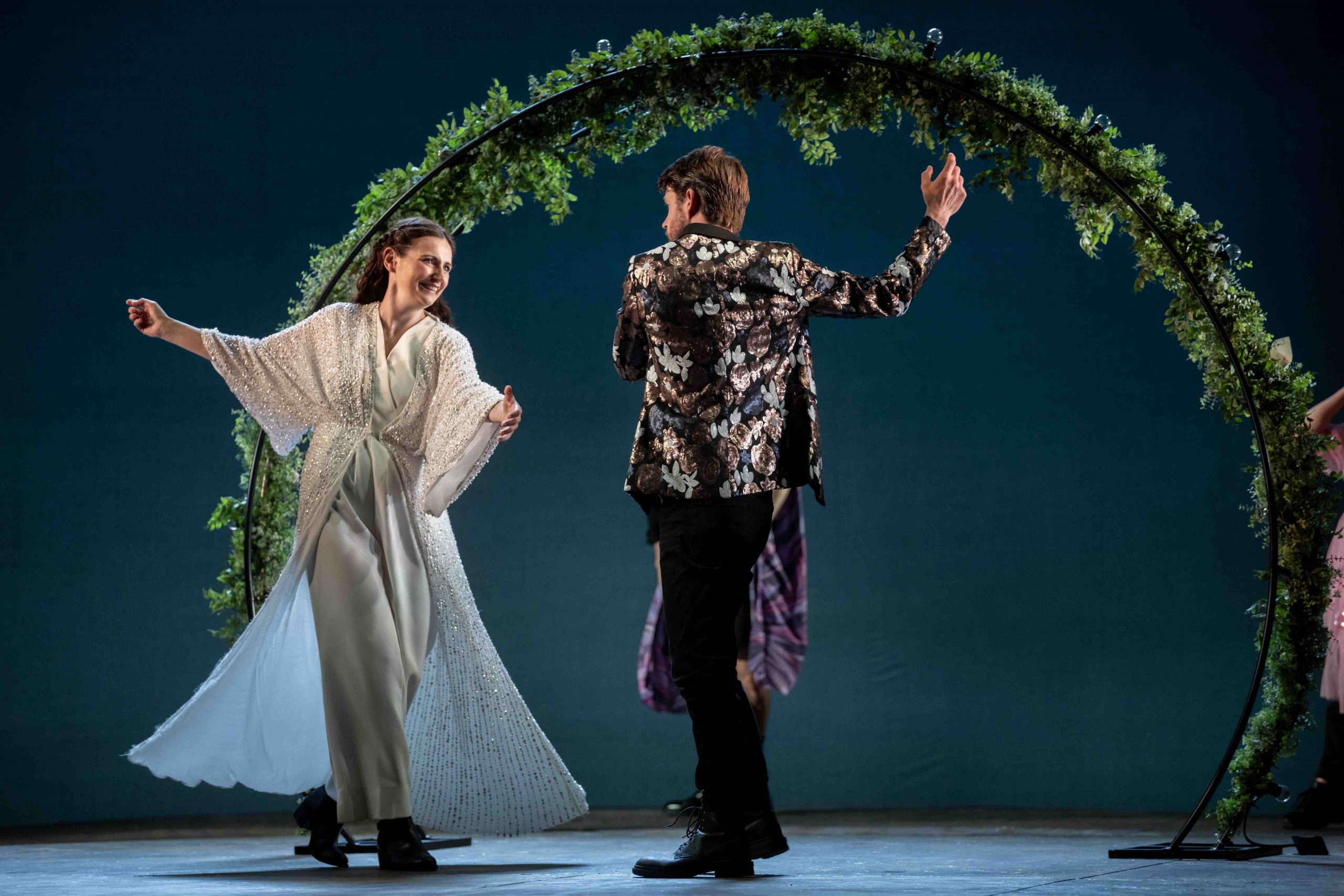
***
The staging of Longborough Festival Opera’s contrasts the playing of Monteverdi’s 1607 score by the Venetian Baroque period musicians of La Serenissima with a show that takes its theme from Glastonbury-style festivals and modern hospitals.
So, in Olivia Fuchs production our Orfeo swaps his lyre for an electric guitar (fortunately it makes no sound) while other rock stars make appearances or are impersonated by the wedding guests (it isn’t clear). I assume we are supposed to know who they are although I only really spotted an Elton John look-alike who did, of course, headline Glastonbury this year. It is Orfeo and Euridice’s wedding celebrations and all is lovely with people donning clothes out of a dressing up box. When the reluctant superstar is persuaded to sing the cast must jig along with quasi modern dance moves as Orfeo and his band bash out their greatest hits – rarely a pretty sight.

Peter Gijsbertsen
Nate Gibson’s set is a slowly spiralling slope to a central space which for the wedding has hanging bowers etc and the stage furniture remains constant for the next hospital scene i.e., the descent into Hades when Euridice is dead (or at least here on life support) and then Orfeo’s encounters with Pluto and Proserpina. He is led to the gates of hell by a finely sung La Speranza from Siân Cameron.
Poor Euridice now appears on a hospital trolley bed with a drip and monitor attached and a white sheet lowers to become the backdrop.

The underworld’s boatman Caronte sung by Freddie Tong as a hospital nurse in scrubs pushing the hospital bed-trolley. Orpheus’ great outpouring of sublime singing is not quite enough to seduce him, so a handy bottle of chloroform does the trick and off goes our hero on his unusual, wheeled vessel.
This medical theme is carried through the production with Pluto and Proserpina doubling as senior medics who examine Euridice’s vitals on the ubiquitous hospital bed monitor and stare meaningfully at clipboard charts.
Orfeo’s appeals for his wife are such that Proserpina persuades Pluto to discharge Euridice. Presumably to clear the wards before the NHS consultants’ strike gets underway.

Julien Ségol, Peter Gijsbertsen and Frances Gregory
As Euridice, Aiofe Miskelly sings and plays a suitably modern trouser wearing young woman who is full of life and then full of death as she gets wheeled around on that trolley and then is either covered in a black cloth (along with the other inhabitants of the Underworld) or not. Particularly noteworthy is Frances Gregory as both Euridice’s companion Sylvia and then Proserpina.
Peter Gijsbertsen brings nuance to the role of Orfeo with a more baritonal colour to his tenor voice than we are used to and steering himself through the happiness and despair required in the vocally most demanding of the work’s roles. The final heartfelt aria is most appealing as is that final encounter with Apollo (who for some reason dresses exactly like Orfeo) and in this role Seumas Begg brings glimmers of brightness to the vocal soundscape.
Also particularly enjoyable was Pluto from Julien Ségol and Caroline Taylor’s La Musica. The troupe of musicians and singers take on smaller roles and also perform along with the direction’s requirements, even if at times it looks a little cumbersome and silly.

Caroline Taylor
This is an interesting take on the work but the updating was at the expense of the emotional impact of the story and ultimately our investment in the tragedy.
The stars of the show were the players of La Serenissima under Robert Howarth, with the gorgeous sounds, including Oliver Wass on the harp who I couldn’t quite see, and the clearly visible theorbo played by Lynda Sayce.
Images: Matthew Williams-Ellis
Longborough Festival Opera on 13, 15, 16 and 18 July.